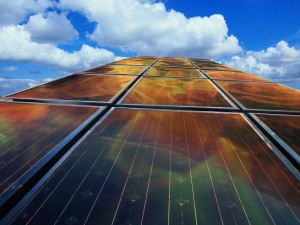
The company said in a press statement that the hybrid system allows extra module heat to be absorbed to produce hot water while optimising efficiency.
The science behind is fairly straightforward. Any PV cell is negatively affected by heat, with output dropping by around 0.5 % for every Kelvin degree. A 10-degree rising in temperature, for example, would mean a loss in power output of about 5%.
Solimpeks scientists succeeded in turning the problem into an advantage with the development of its “PV-Tâ€, described as a hybrid PV and solar thermal collector. The device enables the PV cells to be cooled using water circulating around them. As a result, the electrical output from the cells is bigger and hot water is produced.
Tests showed an improvement of 20% in electric generation compared with conventional PV panels – plus hot water at 140 – 160 degrees Fahrenheit. There are two versions of the Volther Panels: PowerTherm, which is optimized for hot water production; and PowerVolt, optimized for electricity production.
Besides higher efficiency rates, another advantage offered by the system is that less rooftop space is required since only one system is required to carry out solar thermal and photovoltaic functions. Calculations made by scientific and university bodies have shown that an average family house in northern Europe would require only 25 square meters of PV-T collectors to meet its hot water and electricity demands.
Solimpeks said the hybrid PV-T system’s ROI is shorter than standard PV systems. It added that cell lifetime is longer thanks to a reduction in cell temperature.
Volther costs more than conventional PV-only panels, and so does installation. But the cost/benefit ratio does seem to compensate for higher upfront expenses. The product is distributed in Europe and does not have an official distributor in the U.S. However, it can be bought straight from the manufacturer.
Via Jetson Green
You should follow us here.






This is an awesome hybridization concept to increase energy delivery to the customer! I wonder how much more efficient it could be if it were also combined with a heat engine that used the hot water to make even more electricity?
Good morning,
We are small engineering firm in AZ, specializing in solar power generation since 1975. Our hybrid (CPV/T) system produces simultaneously electricity and hot water. Electricity is generated by concentrated photovoltaic (CPV) modules with >40% efficiency. Since we use very high concentration (525 times the sun energy over small areas) the CPV solar cells get very hot (over 300C if not cooled down) so we cool them via coolant (water or glycol) which keeps them operating at high efficiency. At the same time the liquid is heated up to 180F and can be used in open or closed loop heating systems.
We believe that our hybrid CPV/T system could be successfully used in your mix of commercial and industrial applications and marketed as a very efficient use of solar energy in a number of states and countries. The benefits of such “marriage” are numerous, including taking full advantage of the present day energy credits and subsidies.
Please let me know if you’d be interested in looking into this opportunity.
Best regards,
Anco Blazev, Ch.E.
President & CTO
SolarTech of AZ
480-381-7502